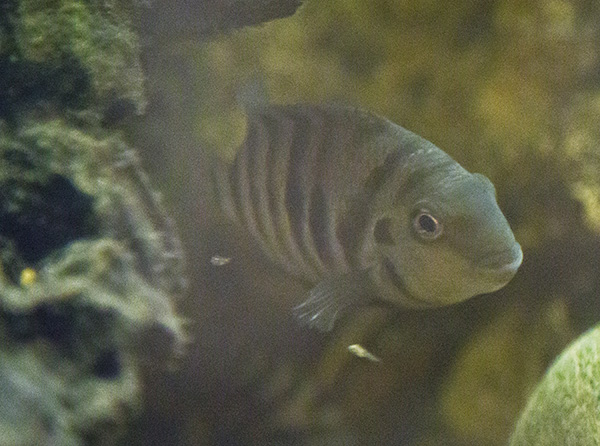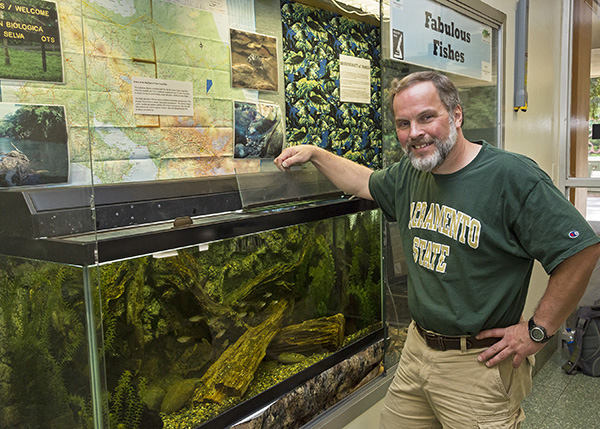 Mama cichlid keeps watch over her kids, one of which is swimming directly beneath her. (Sacramento State/Craig Koscho)
Mama cichlid keeps watch over her kids, one of which is swimming directly beneath her. (Sacramento State/Craig Koscho) Professor Ron Coleman has created an aquascape for Sac State’s Living Gallery. (Sacramento State/Craig Koscho)
Professor Ron Coleman has created an aquascape for Sac State’s Living Gallery. (Sacramento State/Craig Koscho)Related story: "Living Gallery generates new interest in biology"
In the world of freshwater fish, procreation is pretty much the same across nearly all species. After spawning, Mom and Dad either die or swim off, leaving the young to hatch and fend for themselves.
But a few groups have a more caring nature, and one of these is on display at Sacramento State as part of the Department of Biology’s Living Gallery.
The Sequoia Hall display is a 70-gallon glass tank containing convict cichlids (so named for their black-and-white stripes), rainbow cichlids, and tetras.
Of primary interest are the pair of convict cichlids, which laid eggs that have hatched and produced 50 to 80 very, very tiny young ones circling in a small group. “The thing that makes cichlids so interesting is the extent of parental care,” says biology Professor Ron Coleman. “The mother and father work as a team. The female tends to stay close to the babies, and the male patrols the whole tank.”
It’s a good thing. Without the constant surveillance, the colorful tetras would gobble up the young cichlids. But the mother hovers directly over her charges, and the father doesn’t hesitate to attack any tetra that ventures too close.
“As the babies get bigger, they’ll start going where they want, and the parents will do their best to herd them,” Coleman says. “Every now and then there’ll be one adventurous little baby who will head off. Mom usually will grab that baby in her mouth, bring it back and spit it out into the group.”
Coleman decided to create the display because of its potential interest. “Most people are surprised at the diligence of these parents and how devoted they are to their kids,” he says.
He also saw an opportunity to spotlight the department’s fish studies. The exhibit includes preserved specimens such as the California flying fish, bat fish, and the Delta smelt.
The cichlid exhibit represents a small part of the department’s research into these aquatic animals. Every summer for the last 21 years Coleman has traveled to the cichlids’ natural habitat in Costa Rica, where he and a group of students observe them in the wild, studying and photographing them in murky rivers. While the Sequoia Hall tank is a lot clearer, its design represents the fish’s natural surroundings, with a lot of wood and rock.
In the laboratory, cichlids prove to be an ideal research subject, Coleman says. Researchers can remove one of the parents from the tank to see what the other does (it works even harder to protect the kids), or they can drop in a model or picture of a predator and observe reactions.
The convict cichlids in the exhibit are rather gregarious, and may come out from their protective hollow to get a better view of any visitor. “They do look at you and actually are capable of recognizing individual people,” Coleman says.
Anyone who’d like to stop by to make friends with them may do so anytime between 9 a.m. and 4 p.m. Monday through Friday. The exhibit runs through Aug. 25.
For more information, check out a video Coleman taped for an earlier lecture at bit.ly/1XWxk9g or call the professor at (916) 278-3474. – Craig Koscho
In the media:
"Living Gallery fish tank," Channel 31's "Good Day Sacramento"
